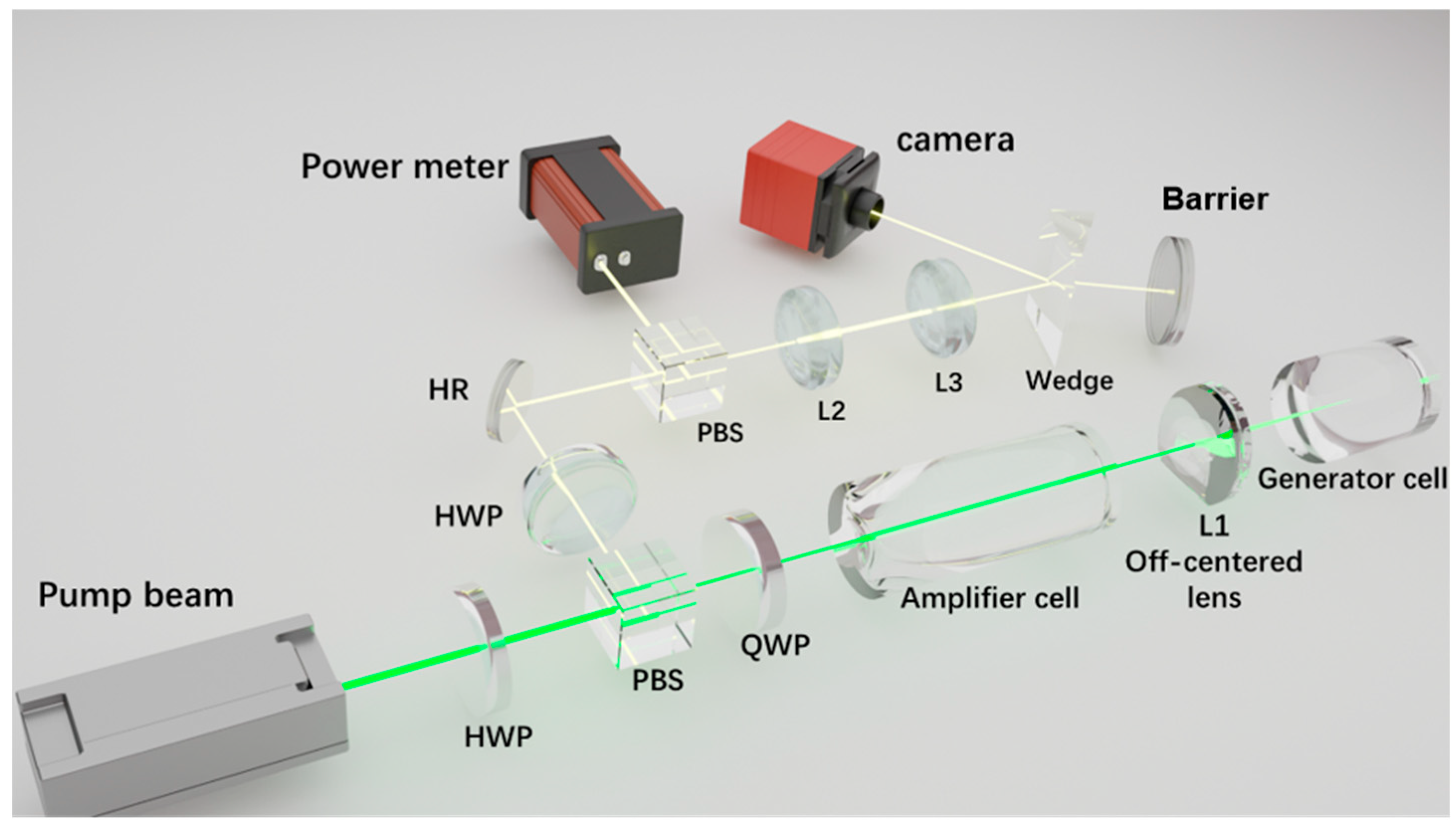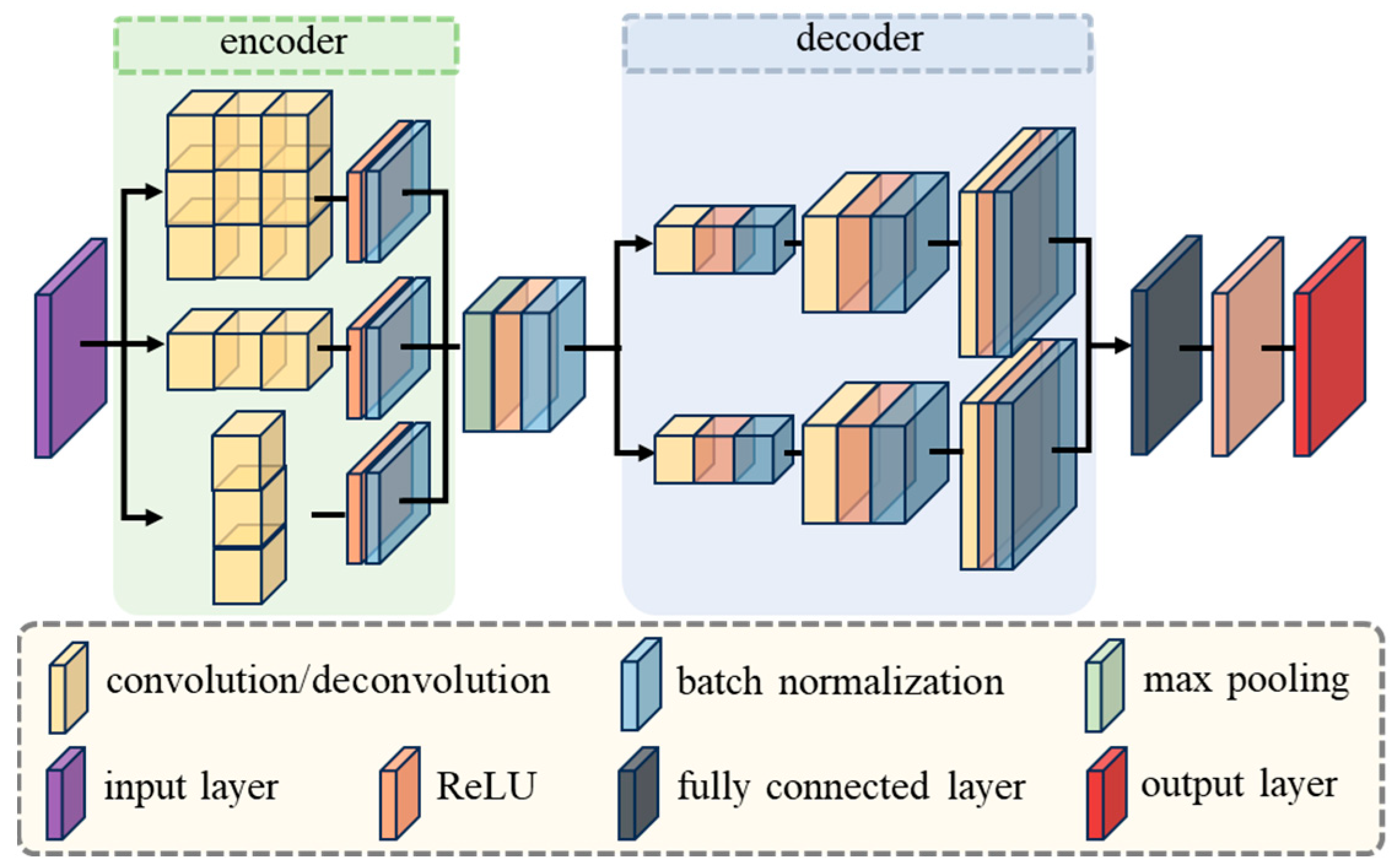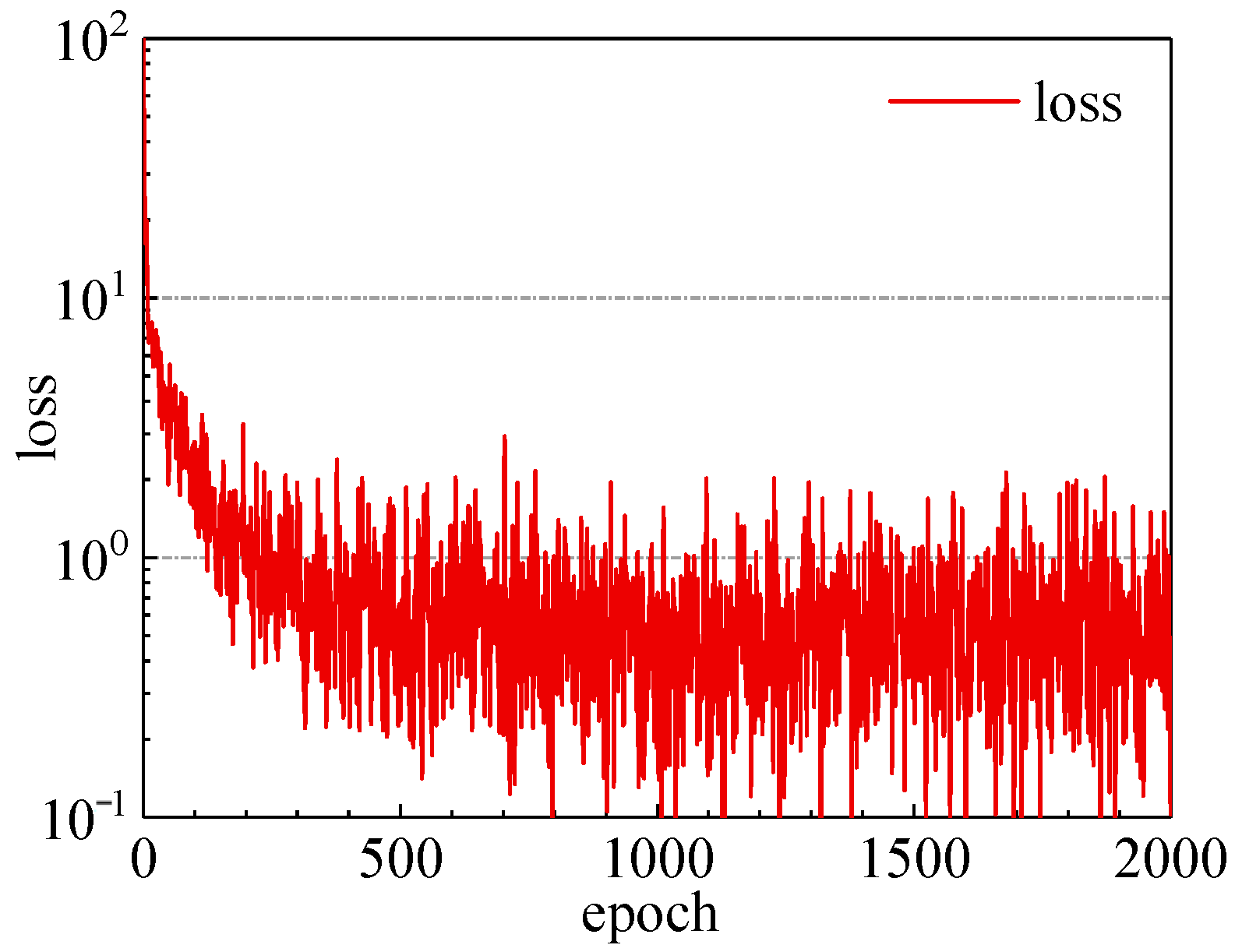Beam Profile Prediction of High-Repetition-Rate SBS Pulse Compression Using Convolutional Neural Networks
Abstract
1. Introduction
2. SBS Experimental Setup
3. Machine Learning for Predicting Beam Spots
3.1. Framework for Machine Learning Model
3.2. CNN Model
3.3. Definition of Loss Function
3.4. Data Preprocessing and Error Evaluation
3.5. Error Metrics and Loss Function Selection
4. Results and Discussions
5. Conclusions
Author Contributions
Funding
Institutional Review Board Statement
Informed Consent Statement
Data Availability Statement
Conflicts of Interest
References
- Feng, C.; Xu, X.; Diels, J.-C. High-energy sub-phonon lifetime pulse compression by stimulated Brillouin scattering in liquids. Opt. Express 2017, 25, 12421. [Google Scholar] [CrossRef] [PubMed]
- Qiu, J.; Tang, X.; Fan, Z.; Wang, H. 200 Hz repetition frequency joule-level high beam quality Nd:YAG nanosecond laser. Opt. Commun. 2016, 368, 68–72. [Google Scholar] [CrossRef]
- Liu, F.; Wang, Y.; Cao, C.; Meng, Z.; Man, Z.; Bai, Z.; Lü, Z. Characterization of sub-nanosecond pulse compression based on frequency-detuning SBS. Opt. Express 2023, 32, 2281. [Google Scholar] [CrossRef]
- Li, H.; Zhao, B.; Jin, L.; Wang, D.; Gao, W. Flat gain over arbitrary orbital angular momentum modes in Brillouin amplification. Photon Res. 2019, 7, 748–753. [Google Scholar] [CrossRef]
- Zhang, X.; Dai, J.; He, T.; Zhao, C.; Huang, J.; Li, X.; Huang, G.; Cao, H. Overview of the Chinese lidar satellite development. In Proceedings of the LIDAR Imaging Detection and Target Recognition 2017, Changchun, China, 23–25 July 2017; SPIE: Washington, DC, USA, 2017. [Google Scholar] [CrossRef]
- Fan, Z.; Qiu, J.; Tang, X.; Bai, Z.; Kang, Z.; Ge, W.; Wang, H.; Liu, H.; Liu, Y. A 100 Hz 3.31 J all-solid-state high beam quality Nd:YAG laser for space debris detecting. Chin. J. Phys. 2017, 66, 054205. [Google Scholar]
- Hatae, T.; Naito, O.; Nakatsuka, M.; Yoshida, H. Applications of Phase Conjugate Mirror to Thomson Scattering Diagnostics. Rev. Sci. Instrum. 2006, 77, 191–210. [Google Scholar] [CrossRef]
- Baumler, W.; Weiss, K. Laser Assisted Tattoo Removal-State of the Art and New Developments. Photochem. Pho Tobiol. Sci. 2019, 18, 349–358. [Google Scholar] [CrossRef] [PubMed]
- Kang, Z.; Fan, Z.; Huang, Y.; Zhang, H.; Ge, W.; Li, M.; Yan, X.; Zhang, G. High-repetition-rate, high-pulse-energy, and high-beam-quality laser system using an ultraclean closed-type SBS-PCM. Opt. Express 2018, 26, 6560. [Google Scholar] [CrossRef] [PubMed]
- Wang, H.; Seongwoo, C.; Kong, H.J.; Wang, Y.; Lu, Z. Thermal suppression of high-repetition rate SBS pulse compression in liquid media. Opt. Express 2022, 30, 38995–39013. [Google Scholar] [CrossRef] [PubMed]
- Chen, Y.; Tan, B.; Jin, D.; Chen, B.; Bai, Z.; Wang, K.; Wang, Y.; Lü, Z. Characteristics and suppression of beam distortion in a high repetition rate nanosecond stimulated Brillouin scattering phase conjugation mirror. High Power Laser Sci. Eng. 2024, 12, 10. [Google Scholar] [CrossRef]
- Park, S.; Cha, S.; Oh, J.; Lee, H.; Ahn, H.; Churn, K.S.; Kong, H.J. Coherent beam combination using self-phase locked stimulated Brillouin scattering phase con-jugate mirrors with a rotating wedge for high power laser generation. Opt. Express 2016, 24, 008641. [Google Scholar] [CrossRef] [PubMed]
- Wang, H.; Cha, S.; Kong, H.J.; Wang, Y.; Lu, Z. Rotating off-centered lens in SBS phase conjugation mirror for high-repetition-rate operation. Opt. Express 2019, 27, 009895. [Google Scholar] [CrossRef] [PubMed]
- Wang, H.; Cha, S.; Kong, H.J.; Wang, Y.; Lü, Z. Sub-nanosecond stimulated Brillouin scattering pulse compression using HT270 for kHz repetition rate operation. Opt. Express 2019, 27, 29789. [Google Scholar] [CrossRef] [PubMed]
- Wang, K.; Tan, B.; Chen, Y.; Wang, Y.; Bai, Z.; Lu, Z. Effect of pump light repetition rate on thermal convection characteristics in liquid SBS-PCM. Infrared Laser Eng. 2023, 52, 20230415. [Google Scholar]
- Ding, X.H.; Guo, Y.C.; Ding, G.G.; Han, J. ACNET: Strengthening the kernel skeletons for powerful CNN via asymmetric convolution blocks. In Proceedings of the IEEE/CVF International Conference on Computer Vision, Seoul, Republic of Korea, 27 October–2 November 2019; IEEE: New York, NY, USA, 2019; pp. 1911–1920. [Google Scholar]
- Hou, S.; Liu, X.; Wang, Z. DualNet: Learn Complementary Features for Image Recognition. In Proceedings of the IEEE International Conference On Computer Vision, Venice, Italy, 22–29 October 2017; pp. 502–510. [Google Scholar] [CrossRef]
- Singh, T.; Vishwakarma, D.K. A deep multimodal network based on bottleneck layer features fusion for action recognition. Multimed. Tools Appl. 2021, 80, 33505–33525. [Google Scholar] [CrossRef]
- Jaiswal, R.; Singh, B. A Comparative Study of Loss Functions for Deep Neural Networks in Time Series Analysis. In Proceedings of the International Conference on Big Data, Machine Learning, and Applications; Springer Nature: Singapore, 2021; pp. 147–163. [Google Scholar]
- Arize, D.; Rios, T.N. A comparison study on time series forecasting given smart grid load uncertainties. In Proceedings of the 2019 8th Brazilian Conference on Intelligent Systems (BRACIS), Salvador, Brazil, 15–18 October 2019; IEEE: New York, NY, USA, 2019; pp. 257–262. [Google Scholar]
- Wu, S.; Li, G.; Deng, L.; Liu, L.; Xie, Y.; Shi, L. L1-norm batch normalization for efficient training of deep neural networks. IEEE Trans. Neural Netw. Learn. Syst. 2018, 30, 2043–2051. [Google Scholar] [CrossRef] [PubMed]
- Kingma, D.P.; Ba, J. Adam: A Method for Stochastic Optimization. In Proceedings of the 3rd International Conference on Learning Representations, San Diego, CA, USA, 7–9 May 2015; ICLR: La Jolla, CA, USA, 2015; pp. 1–15. [Google Scholar] [CrossRef]
- Alipour, M.; Aghaei, J.; Norouzi, M.; Niknam, T.; Hashemi, S.; Lehtonen, M. A novel electrical net-load forecasting model based on deep neural networks and wavelet transform integration. Energy 2020, 205, 118106. [Google Scholar] [CrossRef]







| Case | M/Hz | F/mJ |
|---|---|---|
| 1 | 100 | 10 |
| 2 | 100 | 30 |
| 3 | 300 | 20 |
| 4 | 400 | 40 |
Disclaimer/Publisher’s Note: The statements, opinions and data contained in all publications are solely those of the individual author(s) and contributor(s) and not of MDPI and/or the editor(s). MDPI and/or the editor(s) disclaim responsibility for any injury to people or property resulting from any ideas, methods, instructions or products referred to in the content. |
© 2025 by the authors. Licensee MDPI, Basel, Switzerland. This article is an open access article distributed under the terms and conditions of the Creative Commons Attribution (CC BY) license (https://creativecommons.org/licenses/by/4.0/).
Share and Cite
Wang, H.; Liu, C.; Yan, P.; Niu, Q. Beam Profile Prediction of High-Repetition-Rate SBS Pulse Compression Using Convolutional Neural Networks. Photonics 2025, 12, 784. https://doi.org/10.3390/photonics12080784
Wang H, Liu C, Yan P, Niu Q. Beam Profile Prediction of High-Repetition-Rate SBS Pulse Compression Using Convolutional Neural Networks. Photonics. 2025; 12(8):784. https://doi.org/10.3390/photonics12080784
Chicago/Turabian StyleWang, Hongli, Chaoshuai Liu, Panpan Yan, and Qinglin Niu. 2025. "Beam Profile Prediction of High-Repetition-Rate SBS Pulse Compression Using Convolutional Neural Networks" Photonics 12, no. 8: 784. https://doi.org/10.3390/photonics12080784
APA StyleWang, H., Liu, C., Yan, P., & Niu, Q. (2025). Beam Profile Prediction of High-Repetition-Rate SBS Pulse Compression Using Convolutional Neural Networks. Photonics, 12(8), 784. https://doi.org/10.3390/photonics12080784




